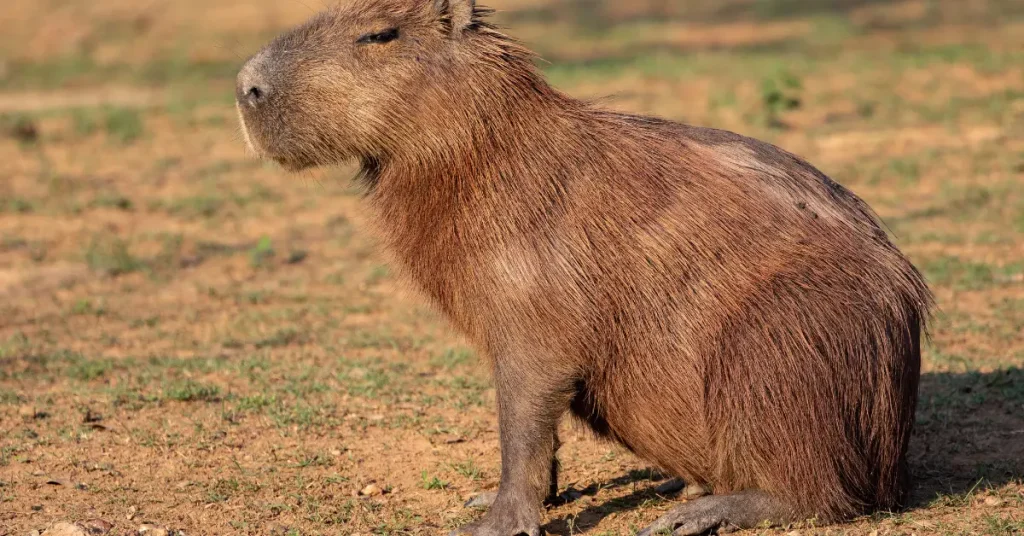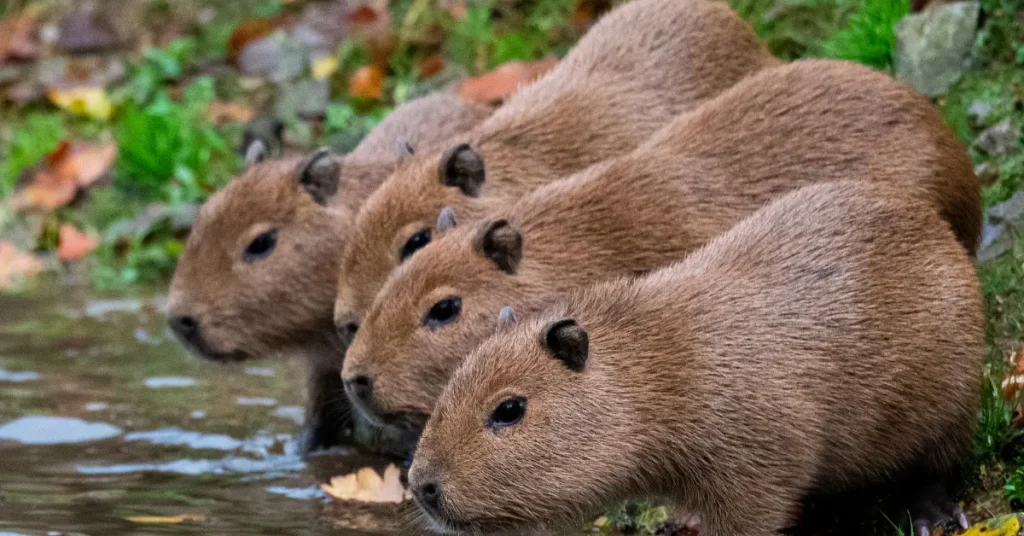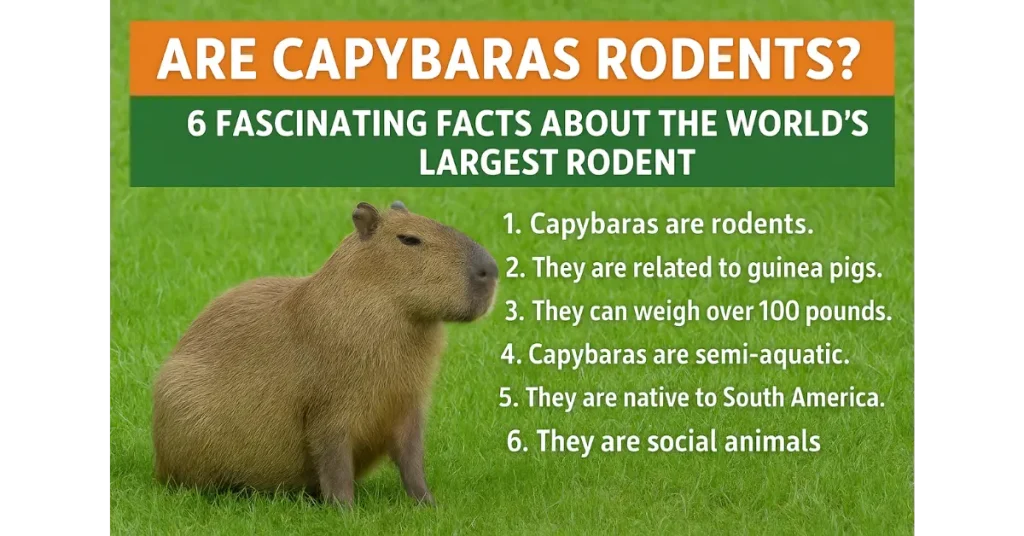Capybaras are friendly, barrel-shaped animals that look part pig, part giant guinea pig. Despite their unusual appearance, they are indeed rodents – in fact, the largest rodents on Earth. Native to South America, capybaras live near water and move in large herds. In this article we’ll explore six fascinating facts about capybaras, including why they hold the title of “largest rodent,” what they eat, where they live, and more.
Capybaras are calm, semi-aquatic animals. They are the world’s largest rodents.
Fact 1: Capybaras Are Officially Rodents (and the Biggest Ones!)
Yes – capybaras belong to the order Rodentia. In other words, they are relatives of mice, rats, guinea pigs, and beavers. But capybaras are giant rodents. The capybara (scientific name Hydrochoerus hydrochaeris) is recognized as the largest living rodent species. To give you an idea of their size, adult capybaras can weigh as much as 150 pounds (around 68 kilograms) and measure about 4 feet (1.2 meters) long. Compare that to a beaver or your family pet guinea pig, and you’ll see why capybaras are famously the “giant rodents” of the animal world.
Capybaras are often called “water hogs” or “water pigs” in South America (in part because they love being near water). They are more closely related to guinea pigs and rock cavies than to rats or mice, but their rodent-type ever-growing teeth give them away. All rodents must constantly gnaw or chew to keep their teeth worn down, and capybaras are no exception.
Key points: Capybaras are true rodents, the largest in the world, and grow continuously-sharpening teeth like other members of Rodentia.
Fact 2: Colossal Size and Unique Body Features

Capybaras are impressively large. An adult stands about 2 feet (0.6 meters) tall at the shoulder and about 4 feet long. They can weigh anywhere from roughly 70 to 150 pounds (31–68 kg). Interestingly, female capybaras are often slightly larger than males.
Their appearance is distinctive: capybaras have a heavy, barrel-shaped body, short legs, and a blunt head. They have no visible tail (just a tiny stub), which helps give them a smooth-backed look. Their coat is coarse and dense, usually reddish-brown on top fading to yellowish-brown or gray underneath.
Several physical features make capybaras excellent swimmers and well-adapted to life in the water:
- Webbed toes: Their feet are partially webbed, which helps them paddle through water.
- High head placement: Their eyes, ears, and nostrils sit high on the head, allowing them to see and breathe while mostly submerged.
- Strong legs: The hind legs are slightly longer than the front legs, giving them a powerful push when swimming.
These traits mean capybaras can stay mostly hidden under water to escape predators – only a tiny part of their face pokes out! In fact, they can remain underwater for several minutes when necessary.
Capybaras are sometimes jokingly called “giant water rats” or “huge water guinea pigs.” Despite their size, their faces look gentle and guinea pig–like, and they often exhibit a calm, friendly expression.
Capybara Physical Traits:
- Weight up to ~150 lb (68 kg); length ~4 ft (1.2 m).
- Barrel-shaped, sturdy body; no noticeable tail.
- Webbed toes for swimming; eyes and ears high on head.
- Coarse fur (reddish or brownish) that dries quickly on land.
Fact 3: Habitat – Where Do Capybaras Live?
Capybaras are strictly South American in range. They thrive in warm tropical and subtropical climates, but always near water. You’ll find them in:
- Wetlands: Marshes, swamps, and floodplains.
- Riverbanks and lakesides: They gather along the edges of slow-moving rivers, streams, and lakes.
- Savannas and grasslands: As long as there’s a water source, even seasonally flooded grassland can support capybaras.
- Forest edges: They may also inhabit lightly forested areas if water is nearby.
According to experts, capybaras are “found throughout much of northern and central South America”. This includes countries like Brazil, Venezuela, Colombia, Peru, Argentina, Uruguay, and others. In fact, the Brazilian Pantanal (the world’s largest tropical wetland) is one of the capybara’s prime habitats. There’s even a small invasive population in Florida, USA, believed to have escaped from captivity.
Capybaras cannot survive long without water. They use ponds and rivers to cool off and hide. If water dries up, capybaras gather around any remaining mud holes. During the rainy season, they may break into smaller groups; during the dry season, dozens can cram around a single water source.
Key points: Capybaras are semi-aquatic mammals that live only where water is available. They inhabit floodplains, marshes, and river edges across South America.
Fact 4: Diet and Incredible Digestive Tricks
Capybaras are herbivores – they eat only plant material. Their diet mainly consists of:
- Grasses: The bulk of their diet is grasses and aquatic plants.
- Aquatic vegetation: They relish water plants found in marshes and along stream beds.
- Other plants: Fruits, bark, and tree leaves are also eaten when available.
Like other rodents, capybaras have ever-growing, orange-colored incisors that must be kept worn down by constant chewing. Their teeth are perfectly adapted for grazing on tough vegetation.
A strange but true fact: capybaras eat their own feces – usually in the early morning. This behavior, known as coprophagy, allows them to digest their food twice. Since grasses are hard to digest and grow in protein-poor environments, capybaras benefit from re-eating the small, nutrient-rich droppings they produced the night before. This way, they extract more nutrients from the fiber-heavy diet.
- For example, National Geographic notes: “They eat their own feces in the morning… eating their waste essentially allows them to digest it twice”.
- HowStuffWorks adds: “They eat their own feces (coprophagy), which helps them digest fiber more efficiently”.
Because of this diet, capybaras spend a lot of time grazing each day. They often eat in the morning and evening, and rest during the hottest midday hours. They can graze on land or even while partially submerged in water.
Capybara Diet Facts:
- Strictly herbivorous – mostly grasses and water plants.
- Chews constantly to wear down incisors (like other rodents).
- Unique trick: Practices coprophagy – they eat nutrient-rich morning droppings to absorb more from their food.
Fact 5: Social Life and Capybara Reproduction
Capybaras are highly social animals. They live in groups (sometimes called “herds” or “troops”) with up to 10–20 individuals on average. In some habitats they may congregate into very large groups, even up to 100 capybaras, especially in dry seasons when water is scarce. A typical group usually has one dominant male, several females, and their offspring. Bachelor males (without a family group) may form small all-male groups.
Herd structure: The lead male marks territory with scent glands on his nose. Group members are quite tolerant and often rest closely together, particularly near water to keep cool and watch for danger. Being highly social helps capybaras defend against predators – they have many eyes and ears on the lookout.
Breeding: Capybaras can breed year-round, but births often peak during the rainy season. Gestation lasts about 150 days (5 months). Usually there is one litter per year, with 2 to 8 babies (called pups) at a time. It is common to see 4–5 pups in a litter.
Newborn capybaras are precocial, meaning they are quite developed at birth. Almost immediately after birth, the pups can stand and walk – they need to escape predators quickly. In fact, they are often grazing on grass within a week of being born. Mothers and even other adult females nurse the young. Capybara babies are weaned at about 3 months old, by which time they can eat solid food independently.
Capybara Reproduction Highlights:
- One dominant male usually mates with multiple females (polygynous).
- Breeding occurs year-round, often peaking with rains.
- Gestation ~150 days; litters of 2–8 pups.
- Pups are born able to walk and graze almost immediately.
- Weaned by ~3 months, and females often nurse each other’s young.
Fact 6: Capybaras, Predators, and Human Interest
Capybaras and predators: In the wild, capybaras have many natural predators. On land, jaguars and pumas are chief threats. In water, caimans and large snakes (like the boa constrictor) will try to grab them. Even smaller predators like ocelots, crab-eating foxes, and birds of prey (e.g., caracaras and vultures) can take young capybaras. Humans are also a predator: in some regions capybaras are hunted for meat, hide, and to protect farmland.
- Predators of capybaras include:
- Jaguars and pumas (big cats in South America).
- Caimans (small crocodilians in rivers and swamps).
- Snakes like boa constrictors (which prey on pups).
- Birds of prey (e.g. caracaras, hawks, and vultures, which may snatch babies).
- Humans: In some areas capybaras are hunted for food, leather, or to reduce competition for pasture.
Conservation status: Luckily, capybaras are currently classified as Least Concern by the IUCN. They are widespread and have a large total population. However, local declines have occurred due to habitat loss (wetland drainage) and heavy hunting. In some parts of Venezuela and Peru, overhunting has nearly wiped them out. Preserving wetlands and regulating hunting are important to keep capybaras thriving.
Capybaras and people: These rodents are known for their gentle, sociable nature. In the wild, capybaras often seem to make friends with other animals – for instance, in South America it’s common to see small birds, monkeys, or even domestic dogs perching on or following capybaras. (One famous image shows squirrel monkeys happily riding on a capybara’s back!) Capybaras also tolerate human presence fairly well, and zoos around the world note that they are unusually calm animals.

However, it’s worth noting two perspectives: On one hand, many people adore capybaras for their docile, “big guinea pig” charm and even keep them as exotic pets in places where it’s allowed. They can become quite tame, and a well-cared-for capybara will happily swim, lounge in the sun, and even follow its owner for food (often begging for treats like corn). On the other hand, wildlife experts remind us that capybaras are still wild animals. They have complex social needs (they must live in groups) and require access to water and plenty of space. Without those, even a gentle capybara can become stressed or destructive (nibbling furniture or escaping in search of water).
So, whether you see a capybara in a zoo, on an adventure in the Pantanal, or as a famous “capybara cafe” attraction, remember that beneath that sweet face is the world’s largest rodent – an animal perfectly evolved for swampy life.
Conclusion
Capybaras are truly fascinating creatures. From their status as the world’s largest rodent to their unique diet and social lifestyle, each fact about capybaras is full of surprises. We’ve seen that they are genuine rodents, weighing up to 150 pounds, with a semi-aquatic lifestyle and herbivorous diet. They live in family groups near water in South America’s wetlands and grasslands, and they have adaptations like webbed feet and eyes on top of their heads to thrive there. Capybara young are precocious, and the adults live peacefully together in herds.
Whether you’re surprised to learn that these gentle giants belong to Rodentia, or amused by the idea of them eating their own poop to stay healthy, capybaras capture our attention. These facts hopefully give you a deeper understanding and appreciation of capybaras. Next time you encounter a capybara (perhaps lounging beside a pond or starring in a nature video), you’ll know just how unique and remarkable the world’s biggest rodent really is. Keep wondering, learning, and sharing these fun capybara facts with friends!


